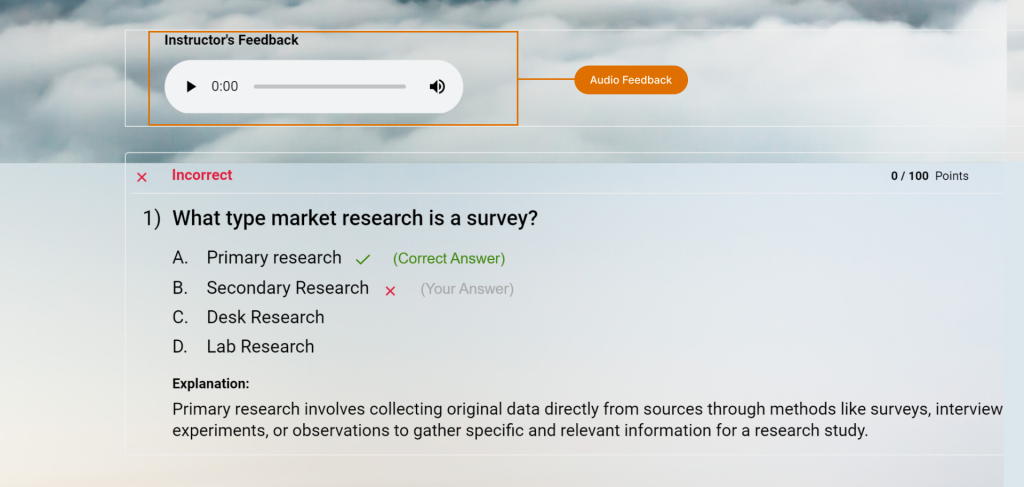Embarking on the educational journey, we often celebrate the milestones, the moments of reflection and achievement that punctuate our path. Summative Assessments are just that—a culmination of our collective efforts in teaching and learning.
More than just a final mark, they embody the depth and breadth of understanding that students have garnered over time. As educators, we recognize their profound impact not only on grading but on guiding our teaching strategies and curriculum development.
This piece delves into the essence of summative assessments, unwrapping their meaning, purpose, significance, and strategies for maximizing their potential.
Let’s dive in.
What Is Summative Assessment?
Summative assessment is the final check on a student’s or employee’s learning at the end of a unit, semester, course, or training program. It aims to capture everything they have learned, offering a clear picture of their knowledge and skills.
Unlike formative assessments, which help guide learning as it happens, summative assessments are about giving final grades or scores.
They are crucial for understanding how much a learner has learned after a period of teaching, using methods like tests, exams, projects, or presentations to gauge student achievement.
Watch: How to Create an Online Assessment Test
What Is the Purpose of Summative Assessment?
Summative assessments do more than just give out final grades; they have several key roles in education:
- Measure Learning: They check how much students have learned at the end of a teaching period, showing their knowledge and skills.
- Inform Everyone: They provide valuable information to students, parents, and teachers about a student’s progress and the effectiveness of teaching methods.
- Improve Teaching: The results help teachers figure out what works well and what needs changing in their lessons and curriculum.
- Ensure Standards: These assessments help make sure that schools and teachers are doing their job well, keeping education quality high.
- Confirm Understanding: These assessments are often needed for students to move on to the next level of education or to meet job requirements, proving they’ve learned what they were supposed to.
Summative assessments are a key part of education, wrapping up learning periods and ensuring students meet learning goals.
Types & Examples of Summative Assessments
Summative assessments are integral in measuring student learning at the end of an instructional period. Each type is designed to evaluate various skills and knowledge areas comprehensively. Here are several key types:
- Standardized Tests: These are broad assessments designed to gauge proficiency against national or state standards.
For example, standardized tests might evaluate students’ reading and math skills, providing a comparative analysis of performance across different educational institutions.
- Final Exams: As comprehensive assessments, final exams test a student’s understanding of all course content. In a literature course, a final exam could involve essay questions about themes, character analysis, and critical interpretations of texts, challenging students to integrate and articulate their learning.
Watch: How to Create Online Tests or Exams
- Projects: Projects allow students to apply their knowledge to practical or creative tasks, encouraging problem-solving and innovation.
A project in a geography class might involve researching and presenting climate change effects in different world regions, showcasing students’ ability to apply geographic concepts to current issues.
- Portfolios: Portfolios are collections of work demonstrating a student’s learning progress and achievements. In disciplines like art or writing, a portfolio could include various pieces that reflect the student’s improvement and mastery over time, coupled with self-reflective commentaries.
- Performances or Presentations: These assessments evaluate the ability to present knowledge or skills publicly. For instance, in a music class, a performance based assessment might involve students performing a piece that demonstrates their technical skills and emotional expression.
- Essays & Written Assignments: This type assesses analytical and writing skills, requiring students to construct well-argued and coherent pieces. An essay in a history class might ask students to compare different causes of a historical event, evaluating their ability to analyze and synthesize information.
- Practical Exams & Lab Work: In subjects that emphasize hands-on skills, such as science or vocational training, practical exams test the application of theoretical knowledge in real-life or laboratory settings.
A chemistry lab exam, for example, might assess students’ ability to conduct experiments safely and accurately, analyzing results to draw valid conclusions.
- Oral Examinations: This assessment type involves students answering questions orally, providing a dynamic way to gauge understanding, critical thinking, and communication skills.
Whether conducted in person, through video conferencing tools, or via audio or video responses in an online quiz, oral examinations challenge students to articulate their knowledge spontaneously and coherently.
This format is particularly useful in language learning, history, or any subject where verbal articulation and reasoning are crucial. It offers educators a direct insight into the student’s thought processes and proficiency in verbal communication.
Watch: How to Create an Audio/Video Response Quiz
These varied summative assessment types enable educators to get a holistic view of student learning, aligning evaluation methods with educational objectives for a comprehensive measurement of student achievement.
How to Create Summative Assessments: Essential Strategies
Creating summative assessments that accurately reflect student learning requires careful planning and strategic design. Here are some key strategies to ensure your assessments are effective:
- Align With Learning Goals
Every aspect of your summative assessment should directly relate to the learning objectives of your course or unit. This ensures that you’re accurately measuring what you intend to evaluate, whether it’s knowledge, skills, or application.
- Establish Clear Criteria
For assessments like essays or projects, develop detailed rubrics that outline expectations for every performance level. Clear criteria help maintain objectivity in grading and clarify expectations for students.
- Ensure Fairness and Accessibility
Design your assessments with all students in mind, including those with special educational needs. Adjust formats, settings, or timing as needed to provide an equitable assessment environment for everyone.
- Incorporate Real-World Connections
Make assessments relevant by linking them to real-world scenarios or problems. This not only engages students but also shows the practical application of their learning, enhancing the value of the educational experience.
- Test and Refine
Before finalizing your assessment, conduct a pilot run to test its effectiveness. Seek feedback on clarity, relevance, and level of challenge. Use this input to refine your assessment, ensuring it meets its intended goals.
- Feedback Is Key
Offer constructive feedback to students after the assessment. Even though summative assessments conclude a learning period, feedback can guide students in their ongoing learning journey, highlighting strengths and areas for growth.

- Diversify Assessment Types
Incorporate a variety of assessment forms to address different learning styles and skills. Mixing written exams, projects, presentations, and practical evaluations can provide a fuller picture of student understanding and abilities.
? Pro Tip:
If you’re creating an online quiz for your summative assessment, make sure you have a mix of question types. Also, include interactive formats, such as drag & drop, hotspot, and video response, to make the assessment more engaging.
Watch: 15+ Question Types for Online Learning & Assessment
Implementing these strategies can help you design summative assessments that are not only comprehensive and aligned with learning objectives but also fair, engaging, and informative for both educators and students.
FREE. All Features. FOREVER!
Try our Forever FREE account with all premium features!
What Are the Benefits of Summative Assessments?
The thoughtful design and implementation of summative assessments offer numerous benefits that extend beyond the simple measurement of academic achievement. Here are some of the key advantages:
- Clarifies Learning Expectations: Summative assessments provide a clear target for students, outlining what they need to learn and achieve. This helps in focusing their study efforts and enhancing their learning strategies throughout the course.
- Motivates Student Engagement: The knowledge that their understanding will be evaluated at the end of a learning period can motivate students to engage more deeply with the material, attend classes regularly, and participate in learning activities.
- Informs Teaching Practices: The results from summative assessments can offer valuable insights into teaching effectiveness. Educators can use this data to identify areas of the curriculum that may need adjustment, refinement, or enhancement.
- Facilitates Curriculum Development: By highlighting student competencies and gaps in knowledge, summative assessments can guide curriculum developers in making informed decisions about curriculum adjustments, ensuring that educational programs remain relevant and effective.
- Encourages Reflection and Self-Assessment: For students, summative assessments can serve as a mirror reflecting their learning journey, encouraging them to reflect on their progress, identify their strengths, and acknowledge areas needing improvement.
- Validates Educational Quality: Summative assessments, especially standardized tests, can serve as benchmarks of educational quality, providing stakeholders with evidence of the institution’s effectiveness in delivering education.
- Prepares Students for Future Challenges: By mimicking conditions students might face in standardized testing or professional certification exams, summative assessments can prepare students for future academic and career-related challenges, building their test-taking confidence and skills.
Watch: How DMS Boosted Student Scores
The strategic use of summative assessments not only enhances the learning and teaching experience but also contributes to a more informed, motivated, and prepared educational community.
Challenges in Conducting Summative Assessments
While summative assessments are critical for evaluating student learning, conducting these evaluations comes with its set of challenges. Addressing these effectively is key to ensuring the integrity and effectiveness of the assessment process. Here are some notable challenges:
- Maintaining Academic Integrity: One of the foremost challenges in summative assessments, especially in online settings, is preventing cheating. The shift to digital platforms has necessitated innovative solutions to uphold academic integrity.
- Diverse Learning Needs: Accommodating the varied learning and assessment needs of a diverse student population can be difficult. Assessments must be designed to be fair and accessible to all students, including those with disabilities.
- Assessment Anxiety: High-stakes summative assessments can induce significant anxiety among students, potentially impacting their performance. Creating a supportive assessment environment and providing clear guidance can help alleviate some of this stress.
- Resource and Time Constraints: Designing, administering, and grading summative assessments can be resource-intensive. This is particularly challenging for educators with large classes or multiple teaching commitments.
Addressing Challenges With Online Exam Software
Online exam software like ProProfs Quiz Maker offer innovative solutions to some of these challenges:
- Cheating Prevention: ProProfs Quiz Maker and similar platforms incorporate features like question randomization, timed tests, browser lockdown, and proctoring tools. These exam settings help reduce the likelihood of cheating by making it difficult for students to predict questions, search for answers online, or take the test outside the allotted time.
- Accessibility Features: Online exam maker software typically includes settings to accommodate diverse learning needs, such as text-to-speech, speech-to-text options, and font customization, ensuring that assessments are accessible to students with disabilities.
- Reducing Anxiety: The ability to practice with similar formats and conditions as the actual assessment can help reduce students’ anxiety. Online platforms often allow for practice tests, providing students with feedback and familiarizing them with the assessment environment.
- Efficiency: Automating the administration and grading of assessments can significantly reduce the time and resources required for summative evaluations.
Online platforms offer automatic grading for objective questions and streamline reporting and student data management, allowing educators to focus more on teaching and less on administrative tasks.
Watch: How to Automate Quiz Scoring & Grading
Additionally, some tools like ProProfs Quiz Maker also offer AI quiz maker capabilities and a rich collection of summative assessment templates, enabling educators to quickly create high-quality, relevant quizzes, further reducing the time and effort required in the assessment process.
Transform Your Approach to Summative Assessments
The journey through summative assessments reveals their undeniable value in education, serving as critical reflections of student learning. However, achieving effective and fair assessments presents challenges, from ensuring equity to managing logistical hurdles.
Enter the realm of technology, where solutions like ProProfs Quiz Maker revolutionize the approach to these challenges. They offer a pathway to not only streamline the assessment process but also enhance its quality, making evaluations more insightful and effective.
As we move forward, leveraging such tools marks a pivotal step in evolving educational practices to better meet the needs of today’s learners and tomorrow’s leaders.
Frequently Asked Questions
What is a summative assessment also known as?
Summative assessments are often referred to as “final assessments” or “end-of-term evaluations” since they are designed to evaluate student learning at the conclusion of an instructional period.
What are the types of tests in summative assessment?
Types of tests in summative assessment include standardized tests, final exams, projects, portfolios, performances or presentations, essays, and practical or lab work.
What is the difference between formative and summative assessment?
The main difference lies in their purpose and timing. Formative assessments are conducted during the learning process to monitor student progress and inform instruction, focusing on feedback and improvement. Summative assessments occur at the end of a learning period, aiming to evaluate overall student learning and achievement. Read this blog post to learn more about formative vs. summative assessments.
Why is summative assessment better?
Summative assessment isn’t necessarily “better” than formative assessment; rather, it serves a different purpose. It provides a comprehensive overview of student learning and achievement after a defined period, useful for final grading, evaluating curriculum effectiveness, and preparing students for future academic or professional endeavors.
 Tips
Tips
We’d love to hear your tips & suggestions on this article!
Write Here
FREE. All Features. FOREVER!
Try our Forever FREE account with all premium features!
 We'd love your feedback!
We'd love your feedback!
What did you like & how can we make it even better?
 Thanks for your feedback!
Thanks for your feedback!
 Ask Your Question
Ask Your Question
Have a question? Get expert help to make your decision easier.
 Thanks for your feedback!
Thanks for your feedback!





